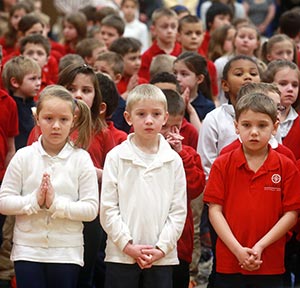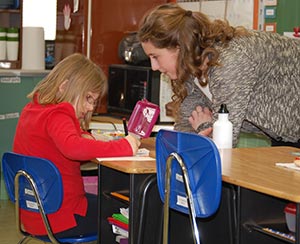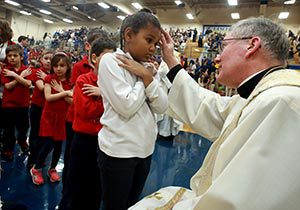What makes a Catholic school Catholic? What sets an institution of Christian learning apart from its peers, making it more than just a private school named after a saint, with a priest on staff? All Saints School, Kenosha, students pray during a city-wide Catholic school Mass to kick off Catholic Schools Week, Monday, Jan. 26, at St. Joseph Catholic Academy, Kenosha. Archbishop Jerome E. Listecki celebrated the Mass. (Catholic Herald photo by Allen Fredrickson)
All Saints School, Kenosha, students pray during a city-wide Catholic school Mass to kick off Catholic Schools Week, Monday, Jan. 26, at St. Joseph Catholic Academy, Kenosha. Archbishop Jerome E. Listecki celebrated the Mass. (Catholic Herald photo by Allen Fredrickson)
As the superintendent of Catholic schools for the Archdiocese of Milwaukee since 2010, it’s not surprising Kathleen Cepelka is passionate about the answer to that question.
“I like to say that the Catholic school really should be a microcosm of the Kingdom of God,” she said. “In other words, if we want to look at what the Kingdom of God is like, that’s what the Catholic school should be: living the Gospel.”
But to live the Gospel is no simple feat, and Cepelka knows that. There is no one element to Catholic education, she said, that makes it truly “Catholic.” A crucifix on the wall and a passively taught religion class is not enough. Instead, Cepelka believes the secret to authentic Catholic education consists of four essential parts, and she relies on her staff and the principals of the 99 elementary schools and 14 high schools in the archdiocese to ensure that each day, all four standards are met.
After all, there are 32,000 students – 32,000 souls – entrusted to the care of Cepelka and the archdiocese’s schools.
“The expectation is that each of these students, Catholic or not Catholic, is being formed to be a believer, to be a disciple,” she said. “That is the essential purpose of the Catholic school.”
Focus on doctrine
First and foremost is the requirement that Catholic schools accredited by the Archdiocese of Milwaukee place heavy emphasis on the instruction of the particulars of the Catholic faith.
It is this requirement, said Cepelka, that illuminates the whole purpose of Catholic education. “The school exists, first and foremost, to advance the teaching mission of the church,” she said. “The school hands on the legacy of Catholicism to its students and is faithful to the message of Jesus Christ as it is handed down by the Catholic Church.”
Jackie Lichter, principal at All Saints School, Kenosha, identifies this focus on doctrine as her school’s primary function.
“Teaching children to see the world through the eyes of Jesus Christ is our mission,” she said. “It is my belief that this begins with me.”
A former theology teacher, Lichter stresses the importance of “intentional faith formation” not only for her students but for her teaching faculty as well, for whom she provides “mini-retreats” that center on prayer and studying.  Rebecca Anderson, right, a senior at Divine Savior Holy Angels High School and member of Christ King Parish, Wauwatosa, works with Emma Viergutz, a student at St. Coletta Day School, Milwaukee, on Friday, Jan. 23. DSHA students are required to complete a credit of service prior to graduation, including a two-week service immersion experience called Vocare. (Catholic Herald photo by Ricardo Torres)
Rebecca Anderson, right, a senior at Divine Savior Holy Angels High School and member of Christ King Parish, Wauwatosa, works with Emma Viergutz, a student at St. Coletta Day School, Milwaukee, on Friday, Jan. 23. DSHA students are required to complete a credit of service prior to graduation, including a two-week service immersion experience called Vocare. (Catholic Herald photo by Ricardo Torres)
“I have learned firsthand the importance of teachers needing to be ‘formed’ in their faith before they can go about the business of forming the children entrusted to them,” she said. “Most teachers graduate from their teacher education programs not having (had) any lessons in how to form Catholic children entrusted to them in their classrooms in their faith. Yet, that is what they are asked to do in a Catholic school.”
Though not all teachers employed by the archdiocese are Catholic, Cepelka said, “there is an expectation that, if at all possible, teachers are Catholic.” Regardless of their faith background, all teachers must have basic certification in religion. For the past four years, the archdiocese has also utilized Cardinal Stritch University’s “Sustaining the Mission” program, a “systematic and highly quality-controlled program of theological formation for all Catholic school teachers and principals,” said Cepelka.
Culturally Catholic
Secondly, said Cepelka, a Catholic school must be “culturally Catholic – from what is on the walls to what is in the textbooks.”
“(This means) that nothing is contrary to the faith, to the way that staff and students and parents treat each other,” she said, adding that school administrators and teachers must set an example by their own faith.
“The best way we learn is to imitate, to see before us an example of what we are told about, and so there’s the quote that’s attributed to St. Francis: preach the Gospel always, and if necessary, use words,” she said. “The first responsibility of the Catholic school teacher or leader is to live the faith him or herself … (students’) understanding of the faith is rooted in the culture of the school, which makes this real for them.”
For Mark Ruedinger, principal at Christ Child Academy, Sheboygan, it is important the culture of Catholicism be manifested in physical symbols his students will recognize.
“We recently installed holy water fonts in each wing of our building, and the children are encouraged to mark themselves with this reminder of their baptisms,” he said, adding that the school also “proudly displays crucifixes, statues of Mary, and many sacred images and sculptures.”
 Fr. Jim Lobacz blesses an All Saints School, Kenosha, student during a city-wide Catholic school Mass to kick off Catholic Schools Week, Monday, Jan. 26, at St. Joseph Catholic Academy, Kenosha. (Catholic Herald photo by Allen Fredrickson)As part of Divine Savior Holy Angels’ Building on Our Faith capital campaign, construction is about to start on a chapel and campus ministry center. The structures will be located “right at the heart of the school,” said principal Dan Quesnell.
Fr. Jim Lobacz blesses an All Saints School, Kenosha, student during a city-wide Catholic school Mass to kick off Catholic Schools Week, Monday, Jan. 26, at St. Joseph Catholic Academy, Kenosha. (Catholic Herald photo by Allen Fredrickson)As part of Divine Savior Holy Angels’ Building on Our Faith capital campaign, construction is about to start on a chapel and campus ministry center. The structures will be located “right at the heart of the school,” said principal Dan Quesnell.
“Obviously, it will be a spiritual space in which we can worship, but also a symbol and a reminder of why we’re there each day,” he said.
Place of prayer
Cepelka urges that Catholic schools be a place where prayer and the sacraments are “regular – part of the culture, the fabric of daily life.”
At Christ Child Academy, Mass and eucharistic adoration are celebrated on a weekly basis, and students are allowed to pray in the day chapel following all school Masses. The sacrament of reconciliation is held twice a year, and every day “begins and ends with prayer,” said Ruedinger, adding, “We embrace and celebrate the differences that set us apart from a public school.”
Students at All Saints, Kenosha, submit their prayer intentions on a daily basis, said Lichter. “We pause when an ambulance goes by and say mini-prayers. We attend Stations of the Cross … and read the Scripture of the day during Lent and Advent. During October and May, each family receives an opportunity to take home our rosary packet and pray together as a family. We attend Mass at least weekly and participate in the sacrament of confession twice a year.” During Lent, a class “gives up” recess and attends adoration in its place.
Formed for service
Lastly, “the Catholic school is a place where students and faculty and staff are really formed to be of service, to not just themselves and their own community but to larger society,” said Cepelka.
“What sets the Catholic school apart in that regard is people don’t just do good things – collect trash or feed the poor, which are great corporal works of mercy – but they really are brought into reflection about those actions to see how they are part of Catholic social teaching,” she said
DSHA requires its students to complete a full credit of service before graduation. This culminates in Vocare, a two-week service immersion experience instituted last year. It is this emphasis on mindful service that Quesnell identifies as a foundation for “the faith-based environment that inspires a different culture within the building” at DSHA.
“It gives kids a framework to look at the world in which we live,” he said. “In the media sometimes we’re bombarded by all of the horrible things that happen, so giving kids the ability to think about the world in the context of faith, and the hope that comes out of believing, I think is an important aspect of teenage life.”
Ruedinger said Christ Child Academy students visit residents at local nursing facilities several times a year, “bringing cheer, small gifts and song.” The students also organize an annual food drive and collect several thousands of dollars for a variety of charities during their K-8 “Penny War.”
“Our kids know we are different,” said Ruedinger. “And that difference is what makes us special as we walk daily in the steps of the Lord.”
